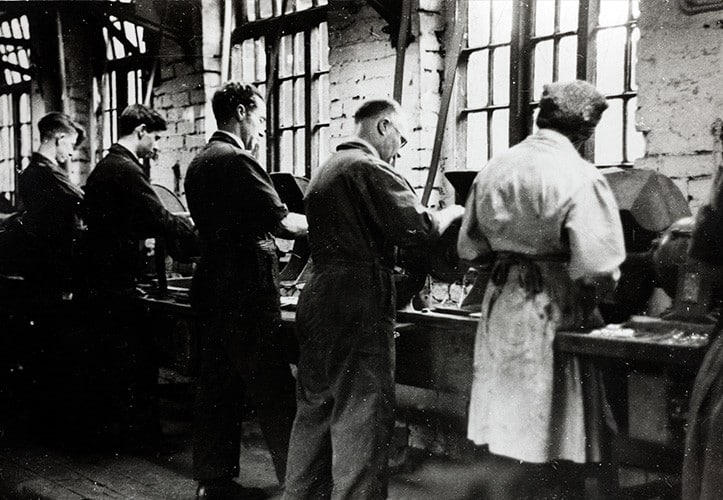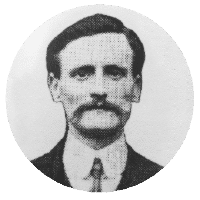+44 (0)1142041541
info@ernestwright.co.uk
$ USD
-
£ GBP
-
$ USD
-
€ EUR
The history of Ernest Wright reflects everything Sheffield Steel has become famous for. Highly skilled craftsmen making supreme quality products. A lot has changed since the heydays of manufacturing, but we’re proud to be here and able to pass on the heritage of an ancient craft.
The Wright family have been involved in the boring, hardening and tempering of scissors since at least the 1800’s.
As far back as records go, Walter Wright – a renowned ‘Little Mester’ of Sheffield – specialised in finishing scissor blades as an outworker and was also referred to as ‘Master Scissor Putter-togetherer’.
A scissor putter-togetherer is the proud title given to the holder of a five-year-to-fully-apprenticed skill set and trade, known and still used by our craftsmen today.


Philip, Graham and Ernest Wright Jr in front.
Since Walter Wright moved into the scissors industry, successive generations have joined the trade. Walter’s son, Ernest, followed in his father’s footsteps to ultimately found the company in 1902. After him, Ernest Wright junior and his sons Graham and Philip Wright all took their turn in running this family business. Finally, fifth generation scissor maker Nick Wright stepped in, until his untimely passing in 2018.
Although not a family operated business anymore, its new owners are fully committed to keeping the Wright-heritage alive. It’s their ambition to prove Ernest Wright is not a museum of a disappearing craft, but a vivid company that produces the finest quality of scissors by hand for a discerning, worldwide audience.
During the first five decades of the century, the company grew steadily, forcing it to move to yet another location, this time on Talbot street.
The arrival of the Second World War meant a slight detour, where we produced surgical equipment in order to avoid merging with a larger company. But by the end of the war, cutlery was in such high demand that the stage was set for the boom that the company experienced in the post-war era.


From the 1950’s right up to the 1970’s, Ernest Wright and Son Ltd. continued to thrive. The new Kutrite trade name was introduced in 1954, and set the brand apart from its competitors.
Through growth and acquisition, the company rose to become a formidable force in both UK and world-wide scissors and tool production and supply.
Employing over eighty workers and exporting to forty five different countries by 1977, Ernest Wright and Son was one of the largest scissors manufacturers in Great Britain. In the year of the company’s 75th anniversary, Ernest Wright Jr. retired and left the company to his sons Graham and Philip.
Right about the time Graham and Philip took over, globalisation set in. Fueled by an economic crisis we saw production move elsewhere, mostly to Asia. Throwaway became a popular term. People liked this new cheap replaceability of goods.
Traditional and Made in Sheffield became rather untrendy.
Where once 40,000 workers were employed in the Sheffield cutlery sector, with about 70 scissor-making companies alone, there were just two left by 1990. And both were a shadow of their former selves.
In 1988, Ernest Wright and Son Ltd went into receivership, only saved by a distant relative stepping in.

Philip Wright managed to take over the business again in 2000 and ran it into the millennium. Relying solely on outwork from larger local businesses, now the company was called Kutrite of Sheffield.
In 2008, Philip’s son Nick joined forces and took over the company in 2012. Nearly going into receivership again, the documentary “The Putter” went viral in June 2014. It reached almost a million views, mostly in the United States, and orders poured in immediately. On top of that, the BBC put a wonderful portrait of another one of our Putters on their international homepage. It rallied half year’s worth of orders, something that hadn’t happened in quite a while!
Then there was the hugely successful Kickstarter campaign to fund the development of an improved version of the famous 1962 Kutrite-model. But it was not to be.
After several setbacks, the Kutrite-project came to a standstill. Both our master-putters fell ill for over 8 months and the new blanks had some major issues. But nobody was prepared for the untimely demise of Nick Wright, in the midst of his efforts to renovate the machinery and deliver all orders in time. Ernest Wright and Son Ltd. went into receivership once more.


Paul Jacobs and Jan Bart Fanoy, two Kickstarter backers, simply could not accept that after 116 years, the art of scissors-making was on the verge of disappearing from Sheffield. In 2018, they took action and bought all assets from the receiver, with the single objective to rescue a great brand, product and heritage. They immediately re-hired master-putters Eric and Cliff, and brought back long-time employee Pam Addy.
Ernest Wright soon strengthened its focus on quality and legacy. The team took on several apprentice putters, including Sam Clark, who became the first trainee of the company’s current era to qualify fully as a putter. Vintage patterns of scissors, including general purpose, paper hanger and quilting models, were brought back into production, and despite extensive disruption caused by the Covid-19 pandemic, work continued on reintroducing the Kutrite pattern of kitchen scissors. The Kutrite was finally brought back in August 2021, marking an emotional milestone in the history of Ernest Wright.
We are focused on perpetuating our values of quality, heritage and craftsmanship, long into the future.
To that end, we’ve been busy developing our premises, and expanding our team. In July 2021, we purchased our workshop premises at 58 Broad Lane, which we immediately renamed ‘Kutrite Works’ – a name used for several Ernest Wright workshops before it. Since then, we’ve been busy expanding and improving the formerly-rented space. There’s been lots to do, from repointing the brickwork and replacing the windows, to creating a stockroom complete with a winch system for moving stock and materials.
We’ve also invested in new machinery to help the putters use their skills and knowledge to the fullest, including a flat-grinder for making the Kutrite kitchen scissors, a new Viotto grinder and a sandblaster. And the team itself has grown, with several newly-hired metalworkers now learning the skills of scissors-making – under the guidance of the master-putters.
The whole team’s passion and effort has gone into equipping Ernest Wright and the craft of traditional scissors-making to thrive long into the future. This made it all the more special when, in 2020, Ernest Wright was awarded the President’s Award for Endangered Crafts, a prize awarded by the Heritage Crafts Association, and initiated by HRH The Prince of Wales.
This remarkable recognition further confirmed something we’d already learned by reading emails and social media comments from our supporters: that there is a renewed interest in real, supreme quality products that reflect the love and attention that has been put into them.
As long as there are people out there who share our obsession with craft, quality and heritage, we’ll keep crafting scissors and shears the good, old-fashioned way.



Ernest Wright
(1880-1954)